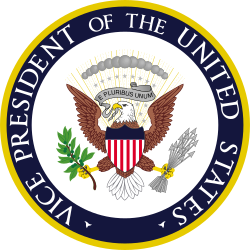James S. Sherman
| James S. Sherman | |
 | |
USA:s 27:e vicepresident | |
| Tid i befattningen 4 mars 1909–30 oktober 1912 | |
| President | William Howard Taft |
|---|---|
| Företrädare | Charles W. Fairbanks |
| Efterträdare | Thomas R. Marshall |
Ledamot av USA:s representanthus | |
| Tid i befattningen 4 mars 1887–3 mars 1891 | |
| Företrädare | John T. Spriggs |
| Efterträdare | Henry Wilbur Bentley |
| Valkrets | New Yorks 23:e |
| Tid i befattningen 4 mars 1893–3 mars 1903 | |
| Företrädare | James J. Belden |
| Efterträdare | Lucius Littauer |
| Valkrets | New Yorks 25:e |
| Tid i befattningen 4 mars 1903–3 mars 1909 | |
| Företrädare | Michael E. Driscoll |
| Efterträdare | Charles S. Millington |
| Valkrets | New Yorks 27:e |
| Född | 24 oktober 1855 Utica, New York |
| Död | 30 oktober 1912 (57 år) Utica, New York |
| Gravplats | Forest Hill Cemetery |
| Politiskt parti | Republikanerna |
| Maka | Carrie Babcock Sherman |
| Namnteckning | |
James Schoolcraft Sherman, född 24 oktober 1855 i Utica, New York, död 30 oktober 1912 i Utica, New York, var en amerikansk politiker som var USA:s vicepresident 1909–1912.[1][2]
Sherman blev advokat 1880 och var borgmästare för Utica 1884–1885.[1] Han blev invald i USA:s representanthus 1886, omvaldes en gång, men förlorade mot Henry W. Bentley i 1890 års kongressval. Sherman återvände till representanthuset två år senare och omvaldes ytterligare sju gånger.
När republikanska partiet nominerade Sherman för ämbetet som USA:s vicepresident, var han ordförande för kommittén för indianärenden, Committee on Indian Affairs, i representanthuset. Som vicepresident tjänstgjorde han 1909-1912 under William Howard Taft. Han kandiderade för omval, men avled några dagar före valet.
Källor
- ^ [a b] Sherman, James Schoolcraft i Nordisk familjebok (andra upplagan, 1917)
- ^ Sherman, James S. i Nordisk familjebok (andra upplagans supplement, 1926)
Externa länkar
- James S. Shermans grav på Find A Grave (engelska)
| |||||||||||||||||||||||
|
Media som används på denna webbplats
James Sherman, Vice President of the United States.
Seal of the Vice President of the United States. The blazon is defined in Executive Order 11884 as:
The design is the same as the Seal of the President of the United States, except that there is no ring of stars, the clouds are gray (instead of proper), the stars are gray (instead of argent), the scroll is gray (instead of white), the arrows are gray (instead of proper), and the background colors and inscription (obviously) differ.The Coat of Arms of the Vice President of the United States shall be of the following design:
SHIELD: Paleways of thirteen pieces argent and gules, a chief azure; upon the breast of an American eagle displayed holding in his dexter talon an olive branch proper and in his sinister a bundle of thirteen arrows gray, and in his beak a gray scroll inscribed "E PLURIBUS UNUM" sable.
CREST: Behind and above the eagle a radiating glory or, on which appears an arc of thirteen cloud puffs gray, and a constellation of thirteen mullets gray.
The Seal of the Vice President of the United States shall consist of the Coat of Arms encircled by the words "Vice President of the United States."
Signature of James Sherman



